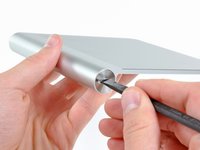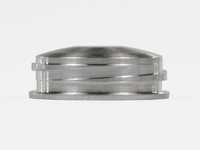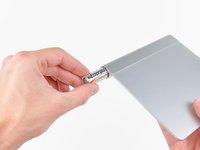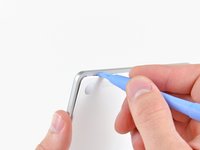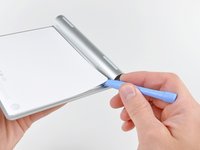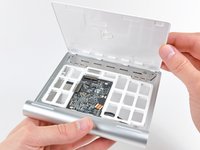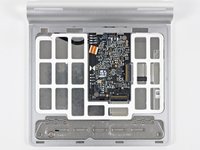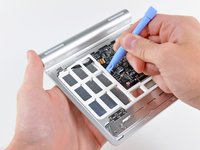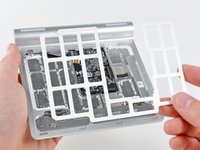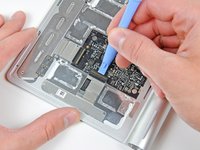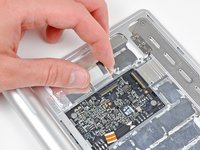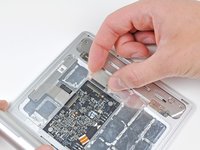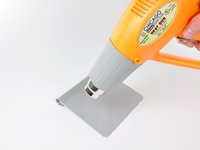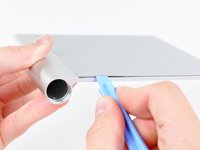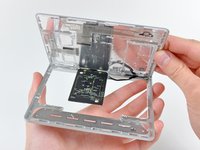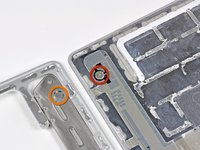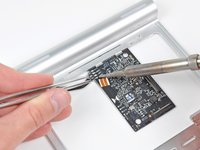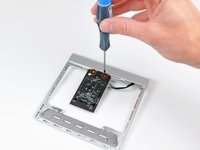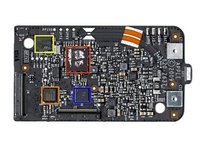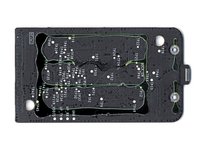Introduction
Have you ever wondered what makes a trackpad magical? Well wonder no more. Join us as we delve into the deep abyss of Apple's ocean of magical peripherals to explore the mysterious Magic Trackpad.
Also check out the magical Vimeo video slideshow of the teardown!
Ce dont vous avez besoin
-
-
The Magic Trackpad is the first full desktop trackpad that supports a full set of gestures, including click, scroll, swipe, and rotate, all available at the tip of your fingers.
-
Requirements:
-
Mac desktop or laptop.
-
Bluetooth connectivity.
-
Mac OS X 10.6.4 or later.
-
And of course, batteries! (Apple Battery Charger not included).
-
As the rumors confirmed, the Magic Trackpad is designated Model A1339.
-
-
-
The Magic Trackpad is 80% larger than the trackpad included in current MacBook Pro models.
-
It features the same aluminum design as its wireless keyboard counterpart, allowing for the perfect union of typing and gestures.
-
Let us not forget the main attraction, which is the 0.5 mm thick, capacitive touch, wear-resistant glass surface.
-
That's all good, but what lies inside?
-
-
-
Removing the batteries is about as straightforward as it can get. Give a twist to the battery door and the two AA batteries slide right out.
-
Check out those square threads! While square threads have the highest mechanical efficiency of all lead screws, their difficulty of manufacturing makes them prohibitive for most applications.
-
Kudos, Apple, for sweating the details.
The Apple Bluetooth keyboard also uses this same Square thread. So it makes sense for them to reuse the same technique they have already invested in. It's these details that makes being an Apple user so fun. Who ever gushes over a screw on a Dell?
The square thread is not very practical for screwing back and finding the right alignment. Also the very thin border of the cap has not very much surface to be hold safely for screwing in.
For undoing a corroded battery you might drill a tiny hole in the bottom and use a screw for wood like a corkscrew. If the second cell is also stuck then you may get hold on a longer drill and longer screw or use a sort of extension. My grandfather has brazed a drill into a piece of tube for such application.
-
-
-
Time to get our hands dirty!
-
Use a plastic opening tool to pry the lower panel away from the adhesive securing around its left, right, and top edges.
-
After slicing through most of the adhesive, the lower panel lifts right off.
Watch out! By accident I managed to break my trackpad "glass" on the top. Do not try to bend the trackpad
Orientation is a funny thing. One persons ‘bottom’ is another person’s ‘top’ and - as in this case - can be confused more so after an item is lifted or picked up, like in the photos. Please be more specific in your descriptions, such as ‘the edge alongside the battery housing’ etc. Thanks!
This tool does it too. Though be prudent as it is an alloy and not the spudger thing. Link: https://www.harborfreight.com/home/hobby...
-
-
-
-
We've noticed a trend about Apple's newer products: thin and pretty = not user serviceable. The Magic Trackpad is no exception.
-
After using a heat gun to warm up the adhesive, the touch pad can be carefully pried off the aluminum chassis.
Hi! I was wondering if you had a temperature scale to give us.
There is lot of plastic on these pretty things, I'd prefer not to deform any part of it with too many heat.
-
-
-
After being freed from the adhesive securing it to the chassis, the touch pad can be easily removed.
The buttons in my Magic Trackpad have an annoying tendency to stop clicking. I have to physically lift up the Magic Trackpad off the desk, place it on the desk again, and suddenly the buttons will click again. It is as if both buttons are physically stuck. But it seems odd that both buttons continually get physically stuck simultaneously.
-
-
-
To completely remove the logic board, you must first de-solder the four wires leading to the battery connector/status LED.
-
After removing two Phillips screws, the logic board can be separated from the chassis.
It looks like there are 4 more contact points, possibly for serial data transmission. Maybe they use these during debugging? They're labeled GND, UPRX, UPTX, and PP1V8. I have no idea what that last one is for...
Maybe you guys should try hooking up something to them and post your results!
I wonder if the power, GND, UPRX, UPTX points could be used to turn one of these into a wired USB trackpad...
Jonathan Hendry! I have the same question and am trying to find out if we can skip the bluetooth process altogether. Do you know any more about these four pins?
I am also pretty interested in such a mod. I got a nonfuntional trackpad with a broken button and a lot of leaked battery fluid. I teared it apart, cleaned it and found the GND, UPRX, UPTX, and PP1V8 contact points. Since the electronics seem to be physically ok, i’d love to get it working again. sadly soldering the battery to the battery connection pins on the pcb wasn’t effective.
I must change the wires that connect the board to power/LED status button , and i dont know what kind of wire to use
And how can i dismantle the power/LED status button ?(it's already out of the battery tube)
-
-
-
At the heart of the Magic Trackpad's logic board lies a Broadcom BCM2042 for Bluetooth connectivity.
-
We found a Broadcom BCM5974 touch screen controller chip that provides Multi-touch functionality.
-
Also, an SST 25WF020 provides 2 Mbit of serial flash memory.
-
This appears to be a TI CD3238, which has been identified by Hearst as a RS232 line driver/receiver. It was also in the original iPhone with a BCM5973A.
-
The back of the logic board features nothing but blackness and glue.
If we paint the trackpad surface (I mean those pad that we touch all the time), does it affects the performance/sensitivity?
-
23Commentaires sur le guide
A great tear down. One question: Where is the bluetooth antenna? Is it just etched into the circuit board?
Good question. It looks like the curved traces along the top of the board seen on step 10 could be the antenna, and they lead to a small metal pressure contact that mates into the aluminum chassis. My guess is that the chassis of the trackpad and/or those curved traces serve as the antenna.
Step 3c, I was expecting to see an Apple-branded battery instead of a bunny-battery. When you get the Apple batteries, is there any reason to tear one of those apart to see if Apple is merely re-labeling someone else's battery or if they actually are building AA batteries?
Apple does not produce batteries, as much as they don’t produce LCD panels or SoC chips - at best, they design them or define specs, but mostly just source it from suppliers, such as Samsung (and SDI), LG and Desay. It makes no financial sense to be a one stop shop - and that’s why Trump’s Nevo-mercantilism is a sure fail. Sorry about the politics - it’s a *charged* topic lolz ;)
Idan -
Step 10, "2Mbit of serial flash memory" This means this device might be capable of storing/receiving data from the attached computer. It will be something we get to investigate to see what type of data it holds to see how it has to be treated in a government setting.
One of the things stored is the device name. When you rename the Magic Trackpad (System Preferences > Bluetooth), that name is saved on the trackpad. It comes up with the same name if you pair it with a different computer: a nice touch!
hoylen -
This is a cool post! I think that the Magic Trackpad is worth owning, and it makes it a pleasure to use the Mac. Unfortunately, it can bug out sometimes. Usually, this is because the battery is running low. It starts to happen after a few hours of continuous use, when the battery life approaches 50%. I wrote up a how-to guide on my site, Appledystopia, for troubleshooting and fixing it. There are some neat tips, like adding it as a Bluetooth Favorite, so if it loses the connection or you toggle the power, it will connect much faster.
I have just destroyed my trackpad by opening it as described. The top of the Bluetooth chip (Broadcom BCM2042) was firmly glued to the plastic cover and when I took the cover off, the chip was ripped off the logic board. Time to buy a new one.. :-(
My batteries leaked inside and to remove them I had to open the screw cap on the battery compartment and sharply hit the trackpad edge on the edge of a table (Preferably wood) with the compartment facing down. The batteries eventually came out and to clean ouit the residue, acid, white crud, I used the handyman's secret weapon, WD40. It works great now !
yes the chip is firmly mastic to the rear panel nice one apple !!!!! probably to stop you repairing it !!
Beware. apple have seriously glued the back of the chip to the rear panel. Nice one apple. Destroyed my pad removing rear panel. But i guess thats what they wanted to achieve.
how much current do these things draw?
Is there a way to fix the button on the track pad if it fell and was scraped and jammed the button
Great presentation. Thank you. Mine also had very severe battery corrosion and I had to drill the 2 batteries out! Very messy but eventually successful. Then I was faced with fixing the switch. Please can you advise how you are supposed to remove the switch/LED pcb assembly without breaking it. Thanks
Hello and Thanks for all Your tutorials ! I have a magic trackpad but it has fallen down and the glass up is broken. Is it possible to repair this part of the device? If it’s possible, where can I buy that parts of the item please? Thanks
My trackpad has stopped responding to mouse clicks - what would you think is the most likely needed to replace to fix that?
To remove the On-Off-Pushbutton on the Side you must remove the Rubber-Foot on the Pushbutton-Side, then with a Little Allen-Key (Imbusschlüssel 0,05) remove the little Ground-Screw, then with the same Allen-Key loosen the Grub-Screw (Madenschraube) under the Ground-Screw (These are the Grond-Connection for the Push-Button)
Next remove the lower Panel like in Step 4. and desolder the 4 Wires (Step 9) from the Logic Board.
Now you can press out the Push-Button with a Long Stick from the Batteries Side and repair.
Norbert
Very good info, thanks ! This should be added to the teardown which IMHO lack this last step ;-)
Col -
Amazing teardown , plus I love how detailed it is, though a question I have is how then would I make my own wireless touchpad With a salvaged A315-53-50k5 laptop touchpad🤔
I thought mine died, but apparently it connected to my (sleeping) MacBook instead of the desktop. So I tapped on Forget device on the MacBook and it instantly connected to my desktop Mac. HTH.
this step by step tutorial works just fine. Improvisation, with a knurled watch repair tool does it! It contains a pointed ball tip and forked tip are another option for those who may want to save time, money and energy ordering the product in the guide above. Though, there may be some slight marking given most watch repair tools are steel or an alloy. There are always pros and cons to different tool types. Link: https://www.harborfreight.com/home/hobby...
Thanks!















